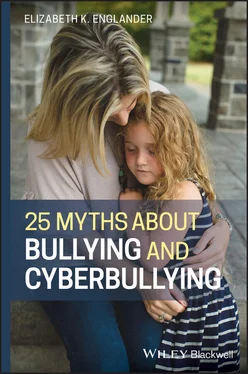Realistically, we can't completely change the adolescent tendency to over‐focus on oneself. But we can keep in mind how much psychological attacks can hurt, particularly in the teenage years, and we can remind our kids that most other teens are more interested in themselves than in others. It's ironic that adolescents can feel so humiliated by a rumor or negative event and so sure that everyone is focused on their humiliation, when the fact is that most teens are focused simply on how they themselves are appearing to others. Sometimes taking the long view can help kids cope with the trauma at hand.
To‐Do for Myth #1: Bullying is usually about a big kid beating up a smaller kid.
The reality: Most bullying is psychological.
Although parents shouldn't exist in a constant state of paranoia about bullying and cyberbullying, it's a good idea to pay attention to how your children are doing socially, and how they're feeling about their friends and peers. Never assume that because you don't see obvious signs – like bruises – everything must be all right. The difficulty is how to talk about these issues with your kids. Here are a few ideas of easy ways to start those conversations:
1 Take advantage of stories you hear on the news or in your community. If there's a story about a bad situation or another child who's a victim, use that story to ask your child about his or her own experiences. Do they think the news story is exaggerated? Is it accurate? Do they see or know about or experience bullying, and what does it look like?
2 Ask your child what kinds of programs their school offers, and ask them their serious opinion of these programs. Are they silly? Boring? Do they miss the point? Were good ideas spread around, or new concepts that they hadn't considered before?
3 Tell your child that you're aware there's a lot of adult anxiety around the idea of digital devices and how kids use them. Ask their opinion about this anxiety, and ask if kids sometimes feel anxious too. What apps or programs are their favorites, and what's fun about them? If they had advice for their younger siblings, or younger kids in general, what would they say, and what do they think younger kids should be taught?
Note: the goal of these conversations can't be to get the skinny the first time out of the box. Your goals are actually fairly simple: you want your child to know that you're interested in these problems and, furthermore, that you're interested in their opinions and thoughts . Don't worry if you’re brushed off at first. Ask their opinion, and ask it genuinely; that's a tactic few targets of conversation are able to entirely resist.
1 1Ronca, D. (2008). Which animals kill the most people in the wild? HowStuffWorks.com. http://adventure.howstuffworks.com/dangerous‐animals1.htm(accessed 11 July 2014).
2 2World Health Organization. (2014). Atlas of African Health Statistics. https://www.humanitarianresponse.info/sites/www.humanitarianresponse.info/files/documents/files/AFRO‐Statistical_Factsheet.pdf.
3 3National Education Association. Parents' role in bullying and intervention. http://www.nea.org/home/56805.htm(accessed 11 July 2014).
4 4Kowalski, R.M., Giumetti, G.W., Schroeder, A.N. et al. (2014). Bullying in the digital age: a critical review and meta‐analysis of cyberbullying research among youth. Psychological Bulletin 140 (4): 1073–1137. https://doi.org/10.1037/a0035618.
5 5Finkelhor, D., Turner, H., Ormrod, R. et al. (2010). Trends in childhood violence and abuse exposure: evidence from 2 national surveys. Archives of Pediatrics & Adolescent Medicine 164 (3): 238–242. https://doi.org/10.1001/archpediatrics.2009.283.
6 6Englander, E. (2013). Bullying and Cyberbullying: What Every Educator Needs to Know. Cambridge, Mass: Harvard Education Press.
7 7Coulter, R., Kessel, S., Schneider, S. et al. (2012). Cyberbullying, school bullying, and psychological distress: a regional census of high school students. American Journal of Public Health 102 (1): 171–177, http://ajph.aphapublications.org/cgi/content/abstract/AJPH.2011.300308v1.
8 8Ando, M. (2005). Psychosocial influences on physical, verbal, and indirect bullying among Japanese early adolescents. The Journal of Early Adolescence 25 (3): 268–297. https://doi.org/10.1177/0272431605276933.
9 9Coyne, S.M., Linder, J., Nelson, D. et al. (2012). “Frenemies, Fraitors, and Mean‐Em‐Aitors”: priming effects of viewing physical and relational aggression in the media on women. Aggressive Behavior 38 (2): 141–149. https://doi.org/10.1002/ab.21410.
10 10Raine, A., Reynolds, C., Venables, P. et al. (1998). Fearlessness, stimulation‐seeking, and large body size at age 3 years as early predispositions to childhood aggression at age 11 years. Archives of General Psychiatry 55 (8): 745. https://doi.org/10.1001/archpsyc.55.8.745.
11 11Perhaps this is a good time to insert a caveat, namely, that I am not against digital technology or its use; that I believe that the Internet has greatly enhanced modern life in many ways, although it has cost us too; and that our children, who will always be heavy technology users, need to learn and practice how to use digital technology, which includes when and how not to use it.
12 12Wang, J., Iannotti, R., and Nansel, T. (2009). School bullying among adolescents in the United States: physical, verbal, relational, and cyber. Journal of Adolescent Health 45 (4): 368–375. https://doi.org/10.1016/j.jadohealth.2009.03.021.
13 13Englander, E. and Muldowney, A. (2007). Just turn the darn thing off: understanding cyberbullying. In: Proceedings of Persistently Safe Schools: The 2007 National Conference on Safe Schools (ed. D.L. White, B.C. Glenn, and A. Wimes), 83–92. Washington, DC: Hamilton Fish Institute, The George Washington University.
14 14Schneider, S.K., O'Donnell, L., Stueve, A., and Coulter, R.W.S. (2012). Cyberbullying, school bullying, and psychological distress: a regional census of high school students. Am J Public Health 102 (1): 171–177.
Chapter 3 Myth #2: Bullying causes suicide and homicide.
** WARNING **
Many parents are understandably worried about the idea that bullying could lead to violence or suicide. And because this is a complicated issue, I'm going to take the time and the space to explain it in detail.
Let's start with what we know and how we know it.
Obviously, some diseases have a clear and simple cause. In those cases, we know that A causes B. The rubeola virus is present in every person who has the measles, so we know that the rubeola virus causes measles. But when it comes to human behavior, that type of clear, simple relationship is unusual. In psychology, most of the time we speak of factors that contribute to behavior or make it more likely, instead of outright causing it.
The mass media, though, prefers simple relationships. A headline reading “BULLYING CONTRIBUTES TO SUICIDE … MAYBE” just doesn't pack the punch of “BULLYING VICTIM DRIVEN TO SUICIDE!” In a nutshell, there is scientific evidence regarding how bullying and cyberbullying are related to homicide or suicide; but the mass media's reporting often seems to inflate our perception of the simplicity, strength, and consistency of that relationship. Dr. Jorge Srabstein conducted a very interesting study of how bullying, injury, and death are handled in modern media. 1 He combed through news reports published throughout North and South America and found that the news media's portrayal of bullying skewed markedly toward the most severe cases. The truth is that only a very tiny fraction of real bullying cases are related to a fatality, but fully 43% of the cases that appeared in the news involved a fatality. Of these, about half involved suicides and half involved homicides. The media's relentless focus on more serious aggression and outcomes is unlikely to be a deliberate attempt to mislead people, but it still has the effect of leaving the public with a lopsided impression of the risks associated with bullying and cyberbullying.
Читать дальше












